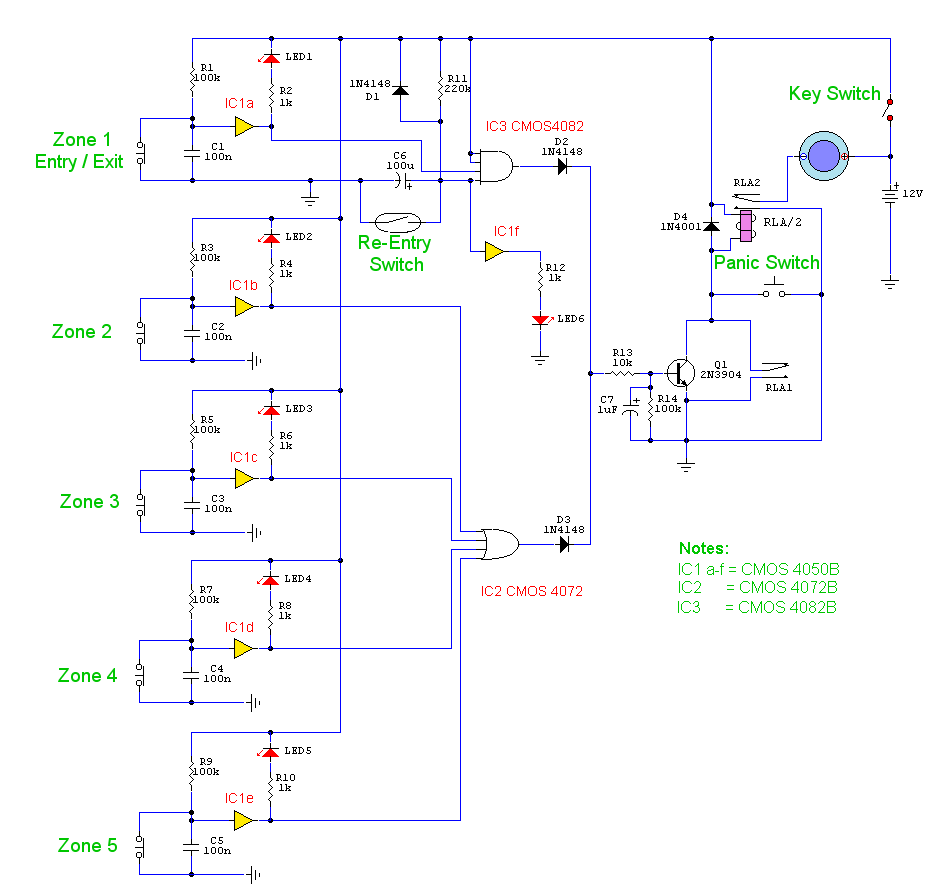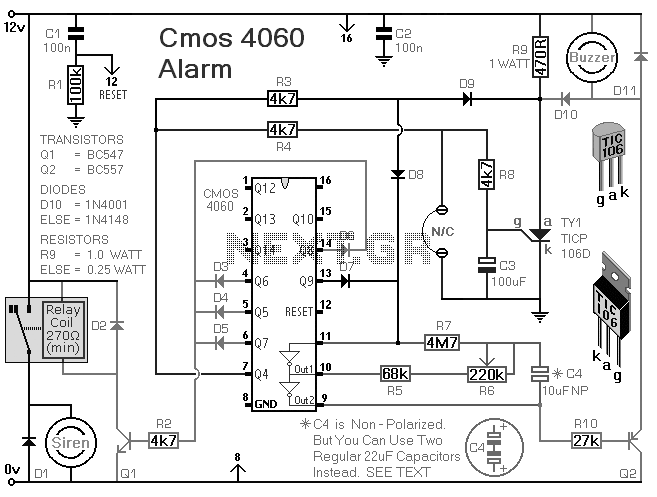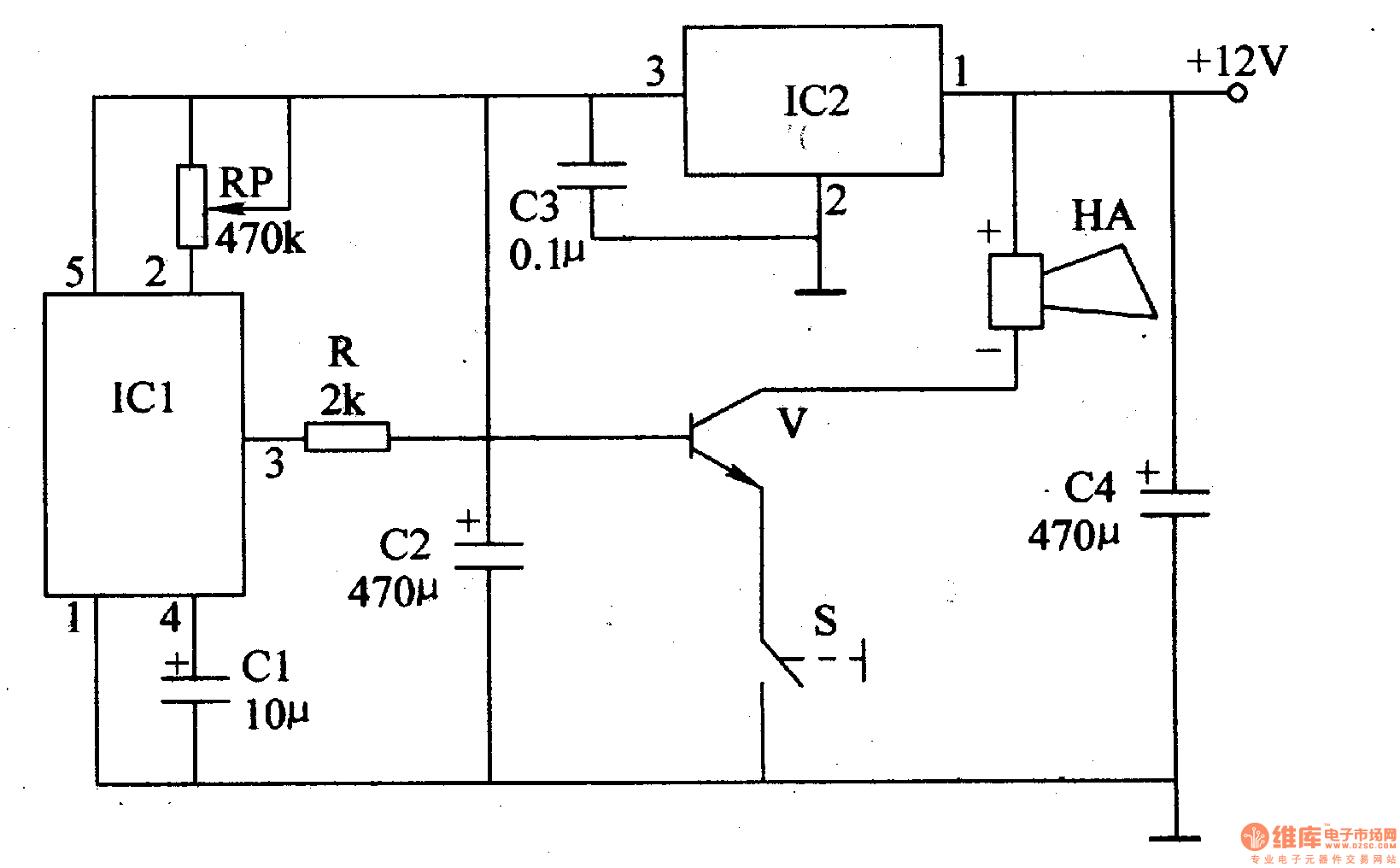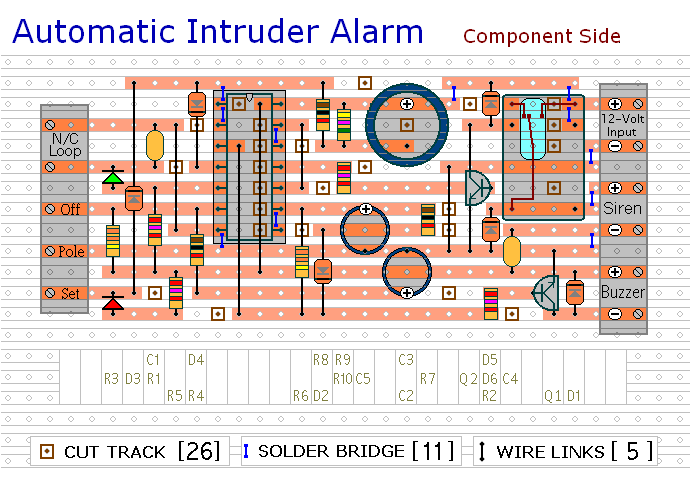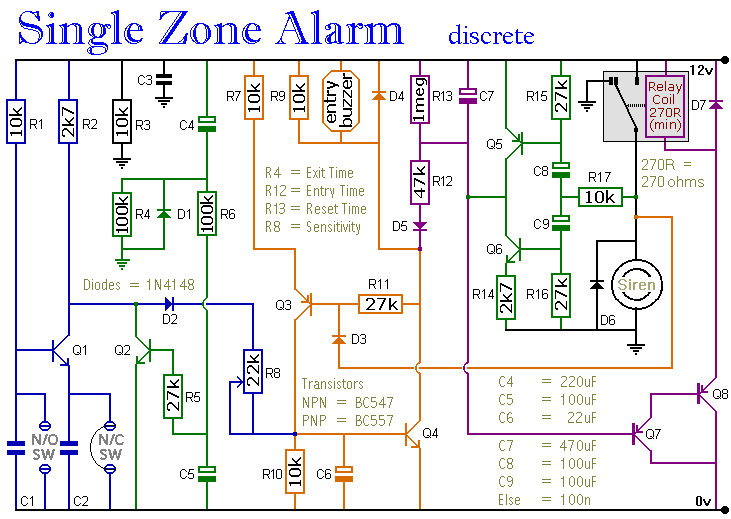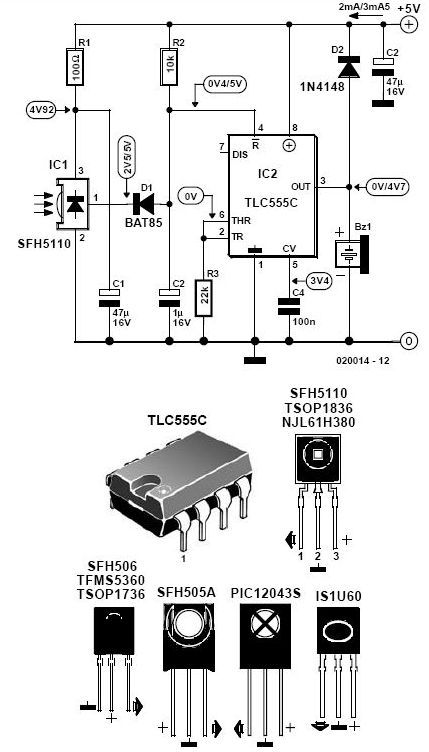
Two-Zone Alarm
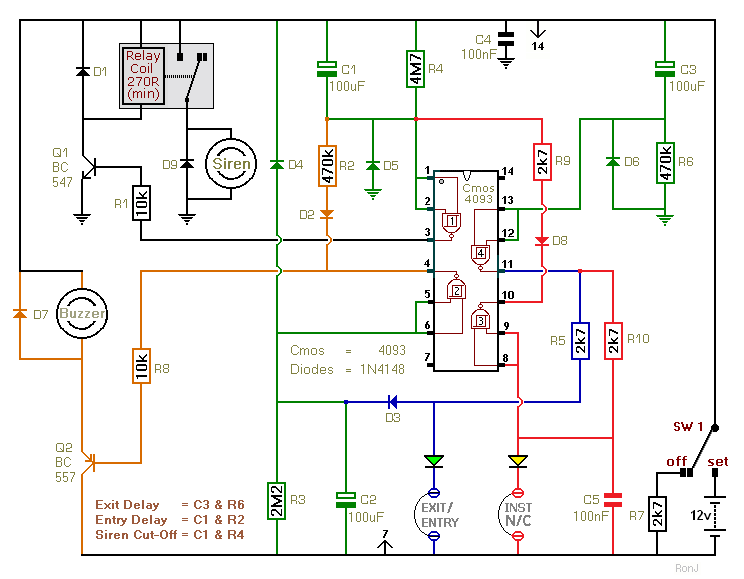
This is a two-zone alarm system featuring automatic exit, entry, and siren cut-off timers. It can be activated by standard normally-closed input devices such as magnetic reed contacts, foil tape, and passive infrared sensors (PIRs). The circuit is designed to operate with a 12-volt power supply, but it is compatible with voltages ranging from 9 to 15 volts. The selection of a siren, buzzer, and relay should correspond to the chosen operating voltage. When the switch (Sw1) is moved to the Set position, there is a 30-second window to exit the premises. If re-entry occurs through the Exit/Entry zone during this time, the buzzer will activate, providing an additional 30 seconds to deactivate the alarm. The Instant zone does not have an entry delay; any entry through this zone will trigger the siren immediately. Approximately ten minutes after the normally-closed loops are restored, the siren will deactivate and the alarm will revert to standby mode, ready to be triggered by another intruder. To prevent the siren from sounding a second time, a One-Time-Only Module can be added, which ensures the siren turns off after the first ten minutes and prevents reactivation. This module has additional applications worth exploring. The timing components are detailed in the schematic, and adjustments to the delay lengths can be made by altering the values of the capacitors and/or resistors in the circuit. Increasing either value will extend the delay, while decreasing them will reduce it.
The two-zone alarm system is designed for enhanced security in residential or commercial settings. The architecture incorporates two distinct zones to provide flexibility in monitoring different areas. The Exit/Entry zone allows for a grace period during which occupants can leave or enter without triggering the alarm, while the Instant zone provides immediate response to unauthorized access.
The input devices, such as magnetic reed contacts and PIRs, are connected to the alarm system through normally-closed loops. This configuration ensures that any interruption in the circuit caused by opening a door or detecting motion will trigger the alarm. The choice of a 12-volt power supply is optimal for most applications, but the circuit's versatility allows it to function effectively with a range of 9 to 15 volts, accommodating various power source options.
The control logic is managed through the use of timing components, which dictate the duration of delays for the exit and entry periods. The timing can be customized by modifying the resistance and capacitance values in the circuit. This adaptability allows users to tailor the system's response times to their specific needs.
The inclusion of the One-Time-Only Module is a notable feature, providing an additional layer of security by ensuring that once the siren has been activated, it will not sound again for a specified period, even if another intrusion occurs shortly thereafter. This is particularly useful in situations where false alarms may be a concern.
Overall, this two-zone alarm system is a robust solution for security, offering customizable features and reliable performance. The schematic provides clear guidance on component selection and timing adjustments, making it accessible for both novice and experienced electronics enthusiasts.This is a two-zone alarm - with automatic exit, entry and siren cut-off timers. It can be triggered by the usual types of normally-closed input devices - such as magnetic reed contacts - foil tape - PIRs etc. I`ve used a 12-volt supply in the diagram - but the circuit will work at anything from 9 to 15-volts.
All you need do is select a siren, buz zer and relay to suit the voltage you want to use. When you move Sw1 to the Set position - you have about 30 seconds to leave the building. If you re-enter through the Exit/Entry zone - the buzzer will sound - and you`ll have about 30 seconds to switch the alarm off. The Instant zone has no entry delay. Anyone entering through the Instant zone - will sound the siren immediately. About ten minutes after the normally-closed loops have been restored - the siren will switch off - and the alarm will return to standby mode.
It can then be re-activated by a subsequent intruder. If you don`t want the siren to sound a second time - add the One-Time-Only Module. It forces the siren to switch off after the first ten minutes. And it prevents the alarm from activating a second time. This module has other uses - so it`s worth a look. The various timing components are listed in the diagram. If you want to change the length of any of the delays - change the value of the capacitor and/or the resistor shown. Increasing the value of either - will increases the delay. And reducing the value of either - will shorten the delay. 🔗 External reference
The two-zone alarm system is designed for enhanced security in residential or commercial settings. The architecture incorporates two distinct zones to provide flexibility in monitoring different areas. The Exit/Entry zone allows for a grace period during which occupants can leave or enter without triggering the alarm, while the Instant zone provides immediate response to unauthorized access.
The input devices, such as magnetic reed contacts and PIRs, are connected to the alarm system through normally-closed loops. This configuration ensures that any interruption in the circuit caused by opening a door or detecting motion will trigger the alarm. The choice of a 12-volt power supply is optimal for most applications, but the circuit's versatility allows it to function effectively with a range of 9 to 15 volts, accommodating various power source options.
The control logic is managed through the use of timing components, which dictate the duration of delays for the exit and entry periods. The timing can be customized by modifying the resistance and capacitance values in the circuit. This adaptability allows users to tailor the system's response times to their specific needs.
The inclusion of the One-Time-Only Module is a notable feature, providing an additional layer of security by ensuring that once the siren has been activated, it will not sound again for a specified period, even if another intrusion occurs shortly thereafter. This is particularly useful in situations where false alarms may be a concern.
Overall, this two-zone alarm system is a robust solution for security, offering customizable features and reliable performance. The schematic provides clear guidance on component selection and timing adjustments, making it accessible for both novice and experienced electronics enthusiasts.This is a two-zone alarm - with automatic exit, entry and siren cut-off timers. It can be triggered by the usual types of normally-closed input devices - such as magnetic reed contacts - foil tape - PIRs etc. I`ve used a 12-volt supply in the diagram - but the circuit will work at anything from 9 to 15-volts.
All you need do is select a siren, buz zer and relay to suit the voltage you want to use. When you move Sw1 to the Set position - you have about 30 seconds to leave the building. If you re-enter through the Exit/Entry zone - the buzzer will sound - and you`ll have about 30 seconds to switch the alarm off. The Instant zone has no entry delay. Anyone entering through the Instant zone - will sound the siren immediately. About ten minutes after the normally-closed loops have been restored - the siren will switch off - and the alarm will return to standby mode.
It can then be re-activated by a subsequent intruder. If you don`t want the siren to sound a second time - add the One-Time-Only Module. It forces the siren to switch off after the first ten minutes. And it prevents the alarm from activating a second time. This module has other uses - so it`s worth a look. The various timing components are listed in the diagram. If you want to change the length of any of the delays - change the value of the capacitor and/or the resistor shown. Increasing the value of either - will increases the delay. And reducing the value of either - will shorten the delay. 🔗 External reference
